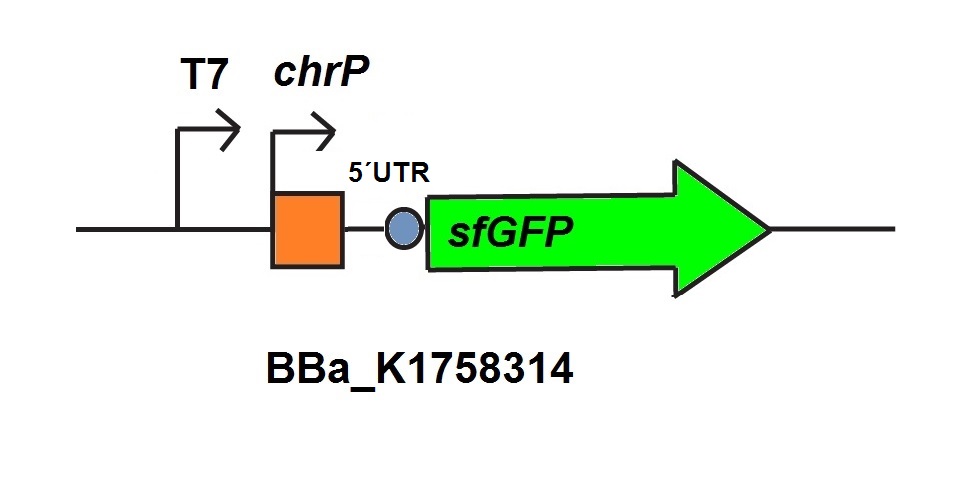Part:BBa_K1758312
Usage and Biology
Our sensor for chromium detection consists of chrB the repressor and the chromate specific promoter chrP. The promoter is regulated by the chrP, used for in vivo characterization , which binds Cr-ions. Behind the promoter is a sfGFP for detection of a fluorescence signal.
In vivo we could show that the addition of different concentrations of chromium have different effects to transcription of sfGFP. e used this repressor for our chromium sensor. Originaly its from Ochrobactrum triti ci5bvl1. We codon optimized it for use in E.coli. It is essential for our chromium sensor device BBa_K1758310. In combination with BBa_K1758313, BBa_K1758314 this part cerates our chromium sensor.Sequence and Features
- 10COMPATIBLE WITH RFC[10]
- 12INCOMPATIBLE WITH RFC[12]Illegal NheI site found at 55
Illegal NheI site found at 966
Illegal NheI site found at 989 - 21INCOMPATIBLE WITH RFC[21]Illegal BglII site found at 1144
- 23COMPATIBLE WITH RFC[23]
- 25INCOMPATIBLE WITH RFC[25]Illegal AgeI site found at 124
- 1000INCOMPATIBLE WITH RFC[1000]Illegal SapI.rc site found at 1237
Results
in vivo characterisation
Our sensors were cultivated in the BioLector. Due to the accuracy of this device we could measure our sample in duplicates.


Our data lead to the conclusion that in a cell based system it is possible to detect chromium. In contrast to our expectations with higher chromium concentrations we got lower fluorescence levels. These observations needed further investigation.
in vitro characterisation
For the characterization of the chromium sensor with CFPS we used parts differing from that we used in vivo characterization. For the in vitro characterization we used a cell extract produced from cells which contain the plasmid (BBa_K1758310). The plasmid contains the gene chrB under the control of a constitutive promoter, so that the cell extract is enriched with repressor molecules. In addition to that we added plasmid-DNA of the chromium specific promoter chrP with 5’UTR-sfGFP under the control of T7-promoter (BBa_K1758314)to the cell extract. The T7-promoter is needed to get a better fluorescence expression.



Chromium’s influence on the cell extract is minimal for low concentrations. Higher chromium concentrations have a measurable impact on the viability of the cell extract, which is visible at concentrations of 120 µg/L and obvious at concentrations of 240 µg/L chromium.

The decrease of fluorescence for higher chromium concentrations in chromium specific cell extract. An increase of fluorescence at higher chromium concentrations would have been expected resulting out of the induction of the chromium sensor.
| None |
